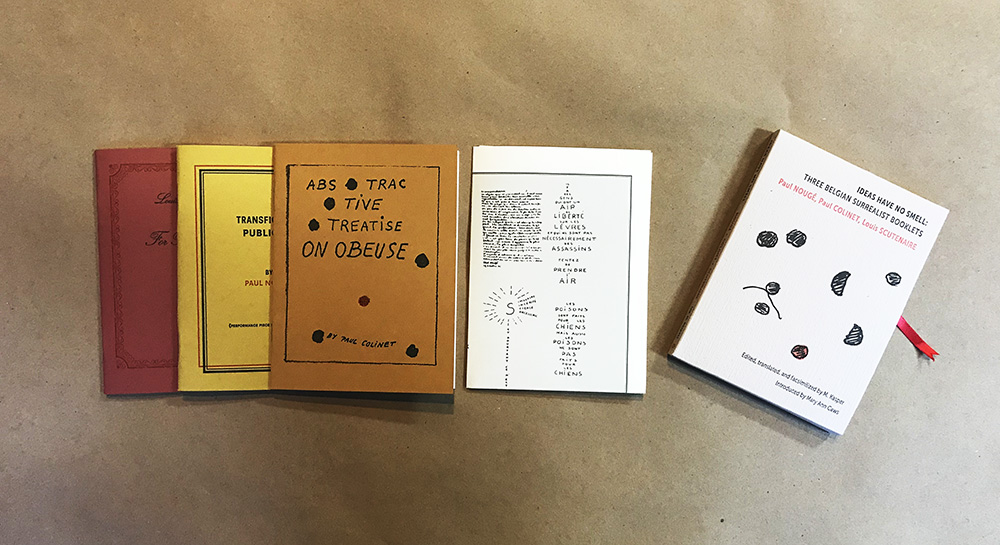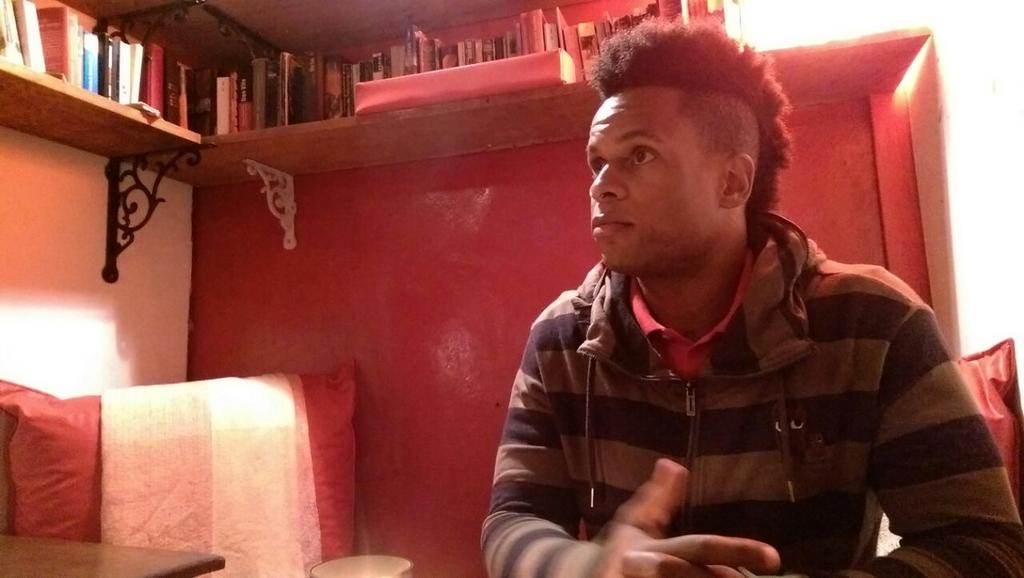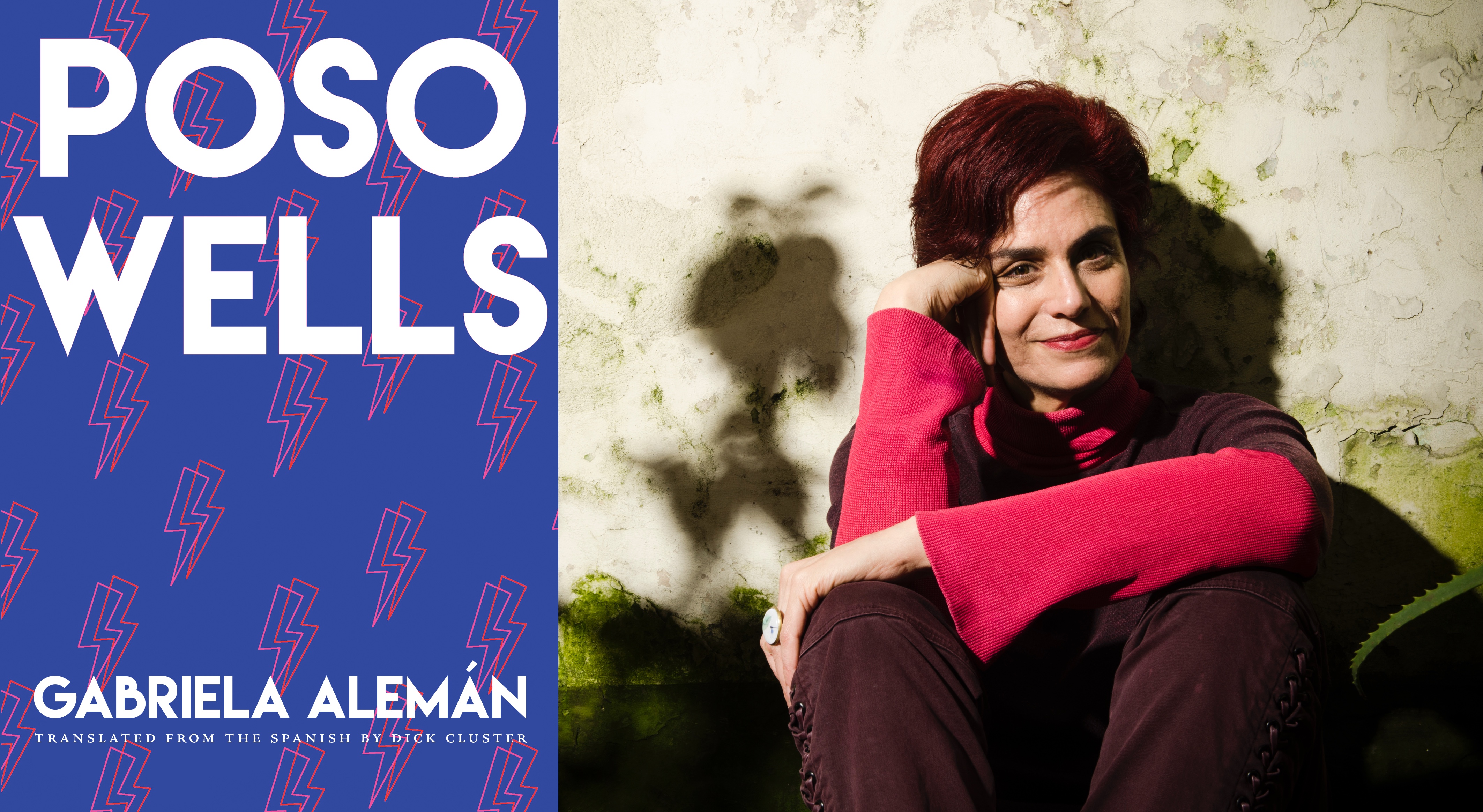In this interview with fiction MFA candidate Sonya Gray Redi, M. Kasper discusses his translation process and how he went about creating facsimile-style translations of some of the ‘unacknowledged literary greats of the twentieth century,’ the Belgian surrealists Paul Nougé, Paul Colinet, and Louis Scutenaire, in his new work Ideas Have No Smell.
M. Kasper’s previous translations are The Lamp’s Tales & Other Short Prose, by Paul Colinet (with Rochelle Ratner; Pleasure Editions), Correspondance: The Birth of Belgian Surrealism (with Jan Baetens; Peter Lang), The Development of Aerial Militarism and The Demobilization of European Ground Forces, Fortresses and Naval Fleets, by Paul Scheerbart (UDP), and Saint Ghetto of the Loans, by Gabriel Pomerand (with Bhamati Viswanathan, UDP). Kasper — who was born in the Bronx (1947), lived overseas for some years, and worked as a librarian for many in Western Massachusetts — has also published artists’ books including Kirghiz Steppes: Accumulated Verbo-Visuals (Black Scat), Open-Book (UDP), The Shapes and Spacing of the Letters (2nd ed., highmoonoon & the London Institute of ‘Pataphysics), All Cotton Briefs(2nd ed., Benzene), and Plans for the Night (Benzene).
How did you first get involved with translation? What attracted you to it?
I’m a longtime reader of translations. I appreciate the access to other mindsets and contexts. In the 1980’s, when I’d already been writing and publishing my own work for some years, I made friends with a visiting Polish poet, Piotr Sommer, who needed help translating his poems into English. It was fun…the collaborating…the close reading…the playing with words without worrying about generating ideas, as I do inordinately, worry that is, when writing my own stuff. Soon after, to try translating on my own, from French, a language I know, somewhat, unlike Polish, I began with a batch of Félix Fénéon’s three-line novels, because they’re fairly straightforward, or seemed so when I started. Frankly, I hardly think of myself as a “translator.” I’ve done it occasionally — and maybe arrogantly, given my language skills— in order to (a) read for myself some un-translated text that’s intrigued me and then, if I’m impressed, (b) share it.
What’s your translation process?
It’s slow. And humbly reliant on collaborators/editors who are native speakers of the original language, most often my francophone friend Jan Baetens, a Belgian poet and academic (whose fascinating book Novelization has just come out from Ohio State University Press, and James Belflower’s translation of one of his poetry collections is seeking an American publisher).
How do you choose which projects to work on and translate?
I’m especially interested in writing that has a visual dimension, that mixes up what’s being said with how it looks, how it’s presented on the page or screen. It’s what I do in my own work: artists’ books. So I translate and then create a facsimile.
How did you first decide to work on Ideas Have No Smell and what attracted you to these three surrealists in particular? Also, what fascinates you about Belgian surrealism as a whole?
I’ve been translating Belgian Surrealists for 20 years. The variety of their work, their commitment to experiment, their brevity, irony, and skepticism, and their rejection of celebrity all inspire me. Ideas Have No Smell was intended to package an engaging selection of their projects — not necessarily typical pieces, which in any case would be hard to define, but exemplary pieces, pieces that also tied into my own taste for visual literature — so as to stimulate interest in their little-known work among English-language readers. These three were the most prominent Belgian Surrealist writers. Nougé, in particular, is one of the unacknowledged literary greats of the 20th century. He experimented with plagiarism from the 1920s onward (significantly influencing the Situationists in the 1950s), and independently theorized about art’s disruptive potential in ways parallel to his contemporaries Shklovsky and Brecht.
I feel like one of the most difficult aspects of this project must have been tracking down the original work itself. How did you go about that and was it as much of a treasure hunt as it seems?
Not particularly, not for me at any rate. I’m retired now, but I worked for decades as an academic librarian, so tracking things down is second nature. I used WorldCat to locate books, and online indexes and hard copy bibliographies and footnotes for citations to secondary sources, and interlibrary loan to actually get hold of material. More difficult, of course, was getting permissions; my pal Jan was critical for those.
What I find most remarkable about these booklets is how it feels that the authenticity and surrealist spirit is preserved and conveyed to the reader. Which of the three booklets was the most difficult to translate, edit, as well as replicate, and why?
I’m delighted that you saw that in the booklets. The Colinet booklet was hardest, not so much for the translating, but because facsimilizing Colinet’s handwritten text, using Photoshop, breaking the letters down to strokes and then reconstituting them effectively was painstaking.
There is a line in Nougé’s “Correspondance” in the Transfigured Publicity booklet that I love: “It’s just when we believe they’re caught that they escape.” It’s stunningly beautiful, and can obviously be applied to many things, but I feel that it is a particularly apt description of translation. Just when you think you have caught the perfect word, that’s when it escapes. Do you agree? Were there any words or ideas in these booklets that you found fit this “untranslatable” category or that you struggled to grab hold of? Any unexpected surprises and challenges?
I like that line too. “On les croyait fixés, c’est alors qu’ils échapppent.” Do you translate from French? How would you render it? As for translation challenges, none of these pieces was terribly taxing, truth to tell, though translating is always a challenge for me, though one I enjoy. Being retired and never doing it for a deadline may help with that.
I do not, unfortunately, translate from French, but from the little I know I’d say you definitely captured it. Do you have any other projects on the horizon?
A revised, second edition of my translation of Gabriel Pomerand’s Saint Ghetto of the Loans is due from Ugly Duckling next summer, and my Englishing of Nougé’s Subversion of the Images, a kind of draft manual on Surrealist visuality, with his own photographic illustrations, will come out from Marc Lowenthal’s Wakefield Press in 2019/20.
Lastly, do you have any tips for emerging translators who are just getting started? Or things you would have liked to have known when you began?
Far be it from me, but…I’ve found it useful to compare different translators’ versions of the same text where possible, even when I don’t know the original language. Also, I don’t believe it’s right to translate already translated texts unless the existing translations are lousy, or incomplete, or lacking in some demonstrable way, since there are still so many worthy, un-translated texts. And the most obvious advice for any writer: read a lot.




